Setup HikVision IP Camera / NVR (Firmware V5.8.4 Build 240613) with CameraFTP VSS software for Cloud Video/Image Recording, Backup, Monitoring and Playback
Contents
Step 1: Connect the camera to the network and find its IP address
Step 2. Access the Camera's Web-based Configuration Tool
Step 3. Configure the video profile
Step 4. Enable Open Network Video Interface
Step 5. Use CameraFTP VSS with HikVision IP Cameras / DVRs
Step 6. Use VSS with Hikvision NVR and CameraFTP Viewer
This Setup Guide Document is for Hikvision cameras with Firmware V5.8.4 Build 240613.
Hikvision is one of the largest security camera manufacturers. They have many camera/DVR models.
Many of their cameras are designed for out-door use. They support image/video resolutions of
2048x1536, 1920x1080, 1280x720 and up to 8MP (4K) resolutions. They can directly upload images to CameraFTP cloud;
but for video storage/backup, you need to use CameraFTP VSS software as a cloud based NVR.
Most Hikvision cameras are compatible with CameraFTP VSS software.
CameraFTP VSS is a video management program for Windows.
It can connect to the video streams of your IP cameras / NVRs, displaying the live videos on your PC screen while also uploading footage
to the cloud or to a local disk. You can use an old PC/laptop as a better and more powerful NVR system.
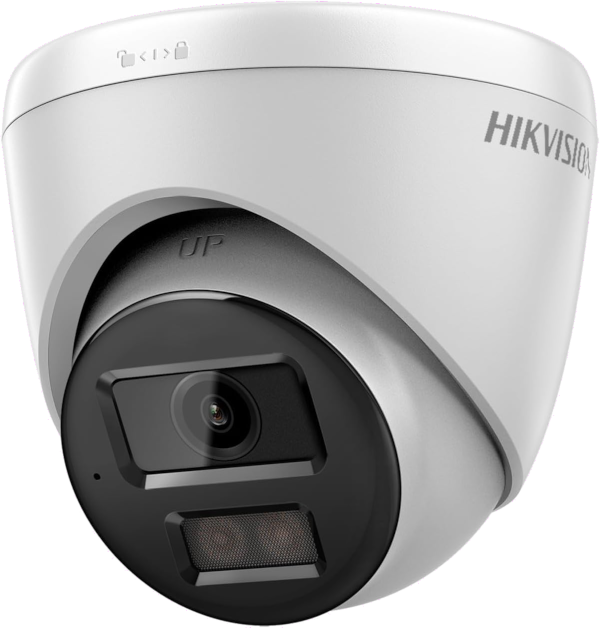 |
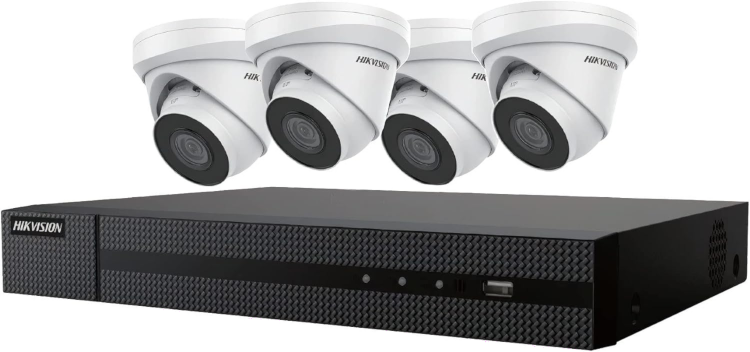 |
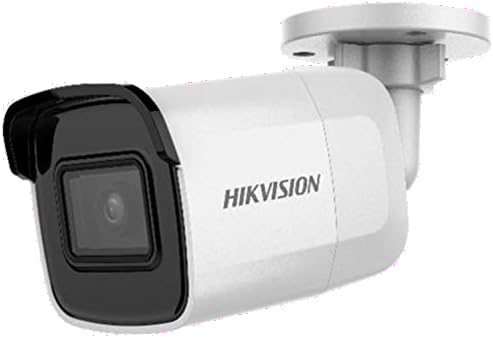 |
| Hikvision_DS-2CD1383G2-LIUF, 8MP PoE network camera |
Hikvision NVR with network cameras |
Hikvision_DS-2CD2085G1-I, 8MP network camera |
Basic camera information
Hikvision Firmware V5.8.4 Build 240613 (June 2024) has changed the device's configuration interface significantly.
It now supports uploading low-resolution (640x480) images using the Sub-Stream video resolution.
However, the main features and steps remain similar to older versions of firmware (or older model devices). It still
does not support uploading video clips via FTP/SMTP; but you can use VSS to record video footage locally or to the cloud.
| Video / image resolution |
3MP, 4MP, 6MP, 8MP (4K), 1920x1080 and 1280x720 dependent on the camera model |
| Audio recording |
Yes |
| Image upload frequency |
1 image/s - 1 image/7 days |
| Video frame rate |
12.5fps |
| Night-vision |
Up to 100 feet for outdoor models |
| Image / Timelapse Recording |
Yes. 1 image/s - 1 images/7 days |
| Video clip recording |
Not Supported (Support with CameraFTP VSS) |
| Motion detection |
Supported |
| Continuous recording |
Supported |
| Supported video format |
N/A (.mp4 with CameraFTP VSS) |
| Connection type |
Ethernet cable |
| PoE (Power on Ethernet) |
Yes |
| Indoor / outdoor |
Outdoor |
| Lowest pricing (as of 6/1/2024) |
$110 (Hikvision DS-2CD1383G2-LIUF PoE Outdoor camera) |
Disclaimer: This document is not designed to
replace the product manual from the manufacturer. The information provided is
based on our knowledge of the model Hikvision DS-2CD1383G2-LIUF PoE outdoor network camera
(with the latest version firmware as of June 2024).
Hikvision has very many camera & NVR models, incl.:
AcuSense Series, ColorVu Series,
DeepinView Series,
Panoramic Series,
Performance Series,
Wireless Series,
Solar-Powered Series,
Value Express Series,
IP PTZ Cameras,
TandemVu Pro Series,
Ultra Series,
Pro Series,
Value Series,
Special Series,
Explosion-Proof and Anti-Corrosion Series,
Explosion-Proof Series,
Anti-Corrosion Series and Network Video Recorders.
We believe the setup interface and steps are similar for all Hikvision network cameras and NVRs.
It may
not be accurate or up-to-date. We have not fully tested these cameras. Users shall contact the manufacturer
for all camera-related issues and contact us only for CameraFTP-related (cloud
service / FTP) issues.
Please follow the manufacturer's instructions to connect the camera to the network.
Many Hikvision outdoor models support PoE.
So you need a PoE switch, or a compatible power adaptor.
You will need to use the manufacturer's software to find the camera's IP address.
After that, you need to launch a browser to access the camera's configuration website.
You might need to download the Hikvision mobile app for the initial configuration. The camera may require you to
change the default password as the first step. The default username is admin. After login to the camera from a browser,
you will be asked to install the plugin for live viewing the camera.
If you connected the camera to the network, but cannot find the camera's IP address, you can use a PC to find it. The PC must
be connected to the same network (LAN). You can install CameraFTP VSS software on the PC, then use it to find the camera's IP address.
You will click Add to add a camera in VSS, then scan the local network to find IP cameras in the local network. Please see the screenshots below:
VSS can find the IP address of the camera; however, it may not be able to find the camera brand/model.
If you are not sure which one is the Hikvision camera's IP address, you can check each IP address with a web browser
by entering the URL: http://Camera-IPAddress/.
In the above screenshot, Hikvision camera's IP address is 192.168.1.64,
which is the default IP address if your local network's subnet is 192.168.1.*.
Please note if you don't want to use the PC as a virtual NVR, please use VSS to find the IP address only. Don't click Next in VSS.
If you have multiple Hikvision cameras, you can connect it one by one. You can change the camera's IP address, or enable DHCP. If you do so,
you need to reboot the camera, wait for it to finish booting, then find the IP address again.
See the screen below about how to change the IP address or enable DHCP:
If you want to find your camera's firmware version, or if it is not the latest version and you want to upgrade it,
please look at the screenshot below:
Now you have the camera's IP address. The next step is to open a web browser to access the camera's web interface.
In the browser address bar, type in http://Camera-IPAddress/. If the address is correct, you will see the following screen: (Otherwise, check each IP address in the above list).
Log in with the camera device's username and password; if this is the first time, you will be asked to set a password for the device first.
After login, you might need to install a plug-in for viewing the camera. If so, click the Plug-in icon to download and install it. After that, it will display the camera live view as follows:
You can then click Configuration to config the camera.
Click Configuration, then click Video/Audio, you can access the video profile settings screen as shown below.
Note: the camera supports 2 video streams: Main Stream and Sub-stream.
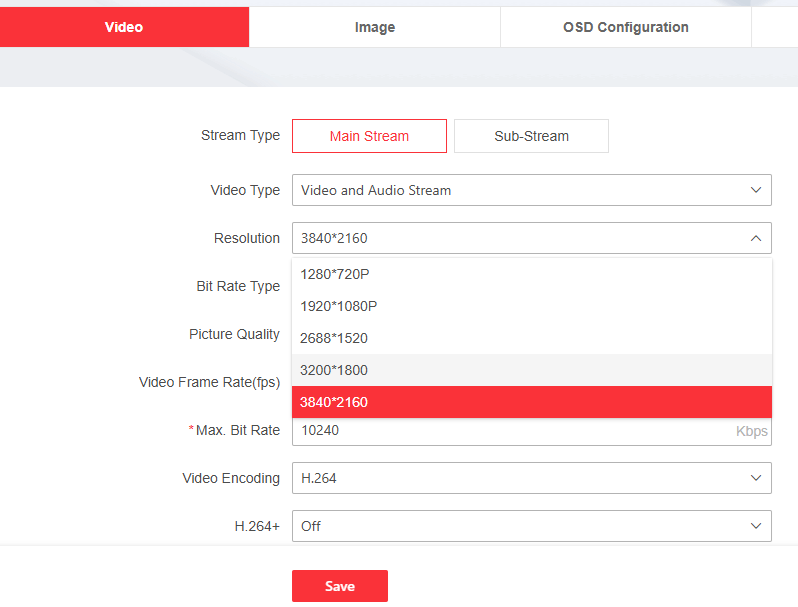
As shown above, the main stream video supports resolutions from 1280P to 4K (8MP).
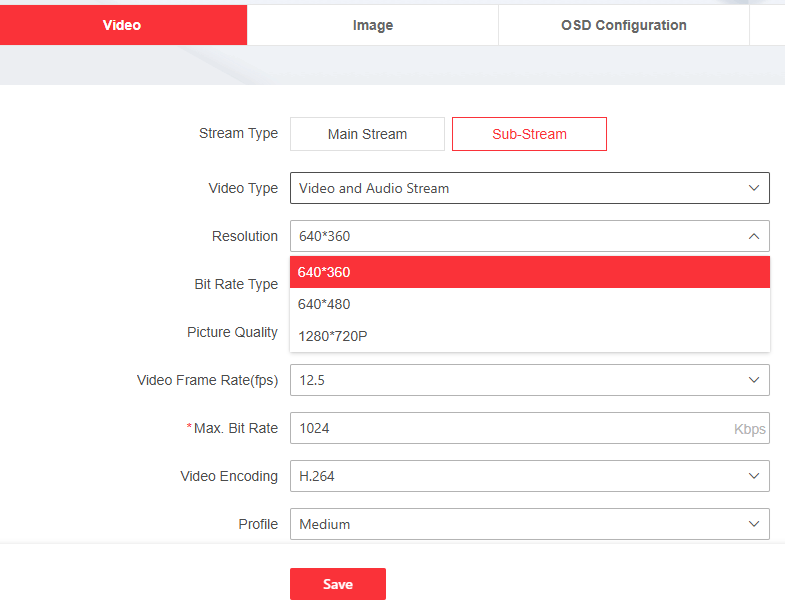
The sub-stream video supports lower resolutions of 640x480 and 1280P.
The parameters to enter are dependent on your subscription plan (camera license). Note VSS can use either the Main Stream or Sub-Stream.
The source video parameters cannot be lower than your camera license's parameters.
CameraFTP VSS can transcode the video stream and upload video or image based on your subscription plan.
If the source video parameters are very high, and if you have multiple cameras, VSS might experience slow performance,
esp. if your PC is old / slow. If so, you can lower your source video parameters. (incl. video resolution, frame rate and bit-rate).
This step will allow the Hikvision IP Camera / NVR to work with 3rd party software like VSS.
Click Configuration -> Network -> Platform Access -> ONVIF, you will see the following screen.
Please Enable ONVIF.
In the above screen, click the Add button to add a user account for ONVIF.
(ONVIF is an open-standard IP camera management protocol).
Enter a username (for example: onvifuser), password, and check "Video user" as shown in the above screenshot, then click Ok.
The new user account is created in your device.
Click Save to save the information.
You can check the RTSP configuration. With an older version firmware, you may need to enable it.
It is now enabled by default. Please see the screenshot below:
NO change is needed. Click Save to save the settings.
CameraFTP VSS software
can use a PC as a CCTV DVR system. It can display live camera videos on your computer screen, while
also recording the video/image to the cloud (and the local disk). HikVision IP Cameras / NVRs are compatible with CameraFTP VSS software.
Using CameraFTP VSS with HikVision IP Camera is easier to setup than uploading directly from the camera; CameraFTP VSS supports both
image recording and video recording at any parameters; it also has more powerful features than a regular IP camera or NVR.
The disadvantage is it requires
a PC and CameraFTP VSS must be always running. (The PC cost is low. You can use an old PC, or buy a new one for less than $300;
One PC/laptop can support multiple cameras or webcams).
Hikvision IP Cameras support the standard ONVIF protocol. However, you might need to manually enable it,
and you must add an ONVIF user account for it to work. Please read the previous chapter.
Now launch CameraFTP VSS software, click Add to add a camera, then click IP Camera. Then click Scan Local Network to
find IP cameras in the same local network. VSS can find the IP Camera very quickly with the ONVIF protocol. Please see the screenshot below:
Select the Hikvision IP camera, click Next.
CameraFTP VSS will display a login dialog. Please enter the ONVIF user info we previously added to the camera device.
Click Next.
CameraFTP VSS will search the camera's video stream URLs. It will display the result as follows:
It found two RTSP video URLs. The first one is the high-resolution main stream video URL,
the second one is the low-resolution substream video URL.
If you ordered a low resolution video recording plan, then select the second URL. Otherwise, you can select the first URL.
Selecting the first URL may use a lot of local network bandwidth. If the camera or PC uses WiFi, please make sure your WiFi connectivity is
fast and reliabe.
The remaining steps are standard. Just click Next and follow the wizard to finish adding the camera. The camera will be added to
VSS as follows:
For a Hikvision IP camera, you are all done.
If you use VSS with a Hikvision NVR/DVR, then you need to repeat the process of adding cameras in VSS software.
When adding a new camera, VSS will display a warning message that the camera's IP address has been added. You can
ignore the message and continue adding the camera, then select a video stream of a different camera (DVR channel). If the NVR/DVR has
N channels (cameras), then it should have at least N video streams.
After a camera(s) is added, it will take about 1 minute for VSS to upload the first video or image.
However, you can view the live video (with audio) immediately from anywhere.
You can use the browser-based viewer by logging in to www.cameraftp.com
or download CameraFTP Viewer App for iOS, Android and Windows.
All viewers support live view and playback from anywhere. Moreover, they support video-calling to the camera.
Cannot get it to work? Please read our
Trouble-shooting Guide.